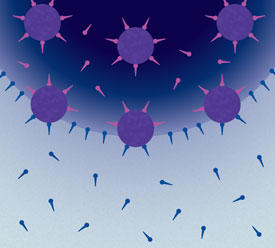

10/29/2018
 Small molecules (pink) surround the nanocrystals (purple), competing with amine-terminated poly(dimethylsiloxane) (blue) for binding to the nanocrystals.
Small molecules (pink) surround the nanocrystals (purple), competing with amine-terminated poly(dimethylsiloxane) (blue) for binding to the nanocrystals.
© 2018 Thomas Russell
A novel form of matter made from nanocrystals with tunable phase-changing properties at interfaces has been created by an AIMR researcher and his collaborators1. They used a tailored chemical additive to control the nanocrystal assembly’s transition between the solid and liquid states. Applications for these dynamic materials range from catalysis and all-liquid electronics to energy storage.
Although colloidal nanocrystals have been used to create many solid structures, nanocrystals that remain in a shape-shifting, liquid-like state have received much less attention, according to Thomas Russell, whose affiliations include the AIMR at Tohoku University, and Brett Helms from the Lawrence Berkeley National Laboratory, USA, who co-led the research.
“Our motivation was to devise a way by which two-dimensional assemblies of nanocrystals at interfaces can undergo solid-to-liquid phase transformations,” Helms explains. When nanocrystal assemblies solidify they adopt a fixed shape, whereas nanocrystal liquids remain deformable with interesting dynamic properties. When these assemblies encapsulate liquids and retain their shape-shifting properties, a host of new applications become imaginable.
The researchers used positively charged iron oxide nanocrystals dispersed in a polar organic solvent and drawn into a syringe. They inserted the syringe tip into a second liquid consisting of amine-terminated poly(dimethylsiloxane) (PDMS-NH2) dissolved in poly(dimethylsiloxane) oil, and then extended a droplet of the nanocrystal dispersion from the syringe tip to create a well-defined interface between the two liquids.
The interesting chemistry happened at this interface, where the PDMS-NH2 from one liquid would bind to the charged nanocrystals in the other to form a stable nanocrystal monolayer (see image) spanning the interface. When the monolayer was compressed by slightly retracting the droplet into the syringe, it ‘jammed’ into a solid state, creating a permanent wrinkled surface on the suspended droplet.
But the material’s properties changed when the researchers added a charged small molecule to the polar organic phase, which could reversibly bind to the nanocrystals and compete with the binding of PDMS-NH2 to the nanocrystals. When the droplet was retracted, the wrinkles appeared, but then disappeared, showing that the nanocrystal monolayer reconfigured back into its dynamic, liquid-like state. Thanks to the use of iron-based nanocrystals, the droplet also transiently deformed when an external magnetic field was applied.
“In essence, we have created a soft magnetic actuator,” Helms says. “In future schemes, the use of catalytically active nanocrystals would allow molecules encapsulated in the fluids to undergo chemical reactions.” Such a system could function like a battery, allowing energy to be stored chemically and later released.
The team is continuing to explore the system’s novel dynamic properties, Helms says. “Our next step is to translate the approach to three-dimensional printed objects from two immiscible fluids.”
This research highlight has been approved by the authors of the original article and all information and data contained within has been provided by said authors.